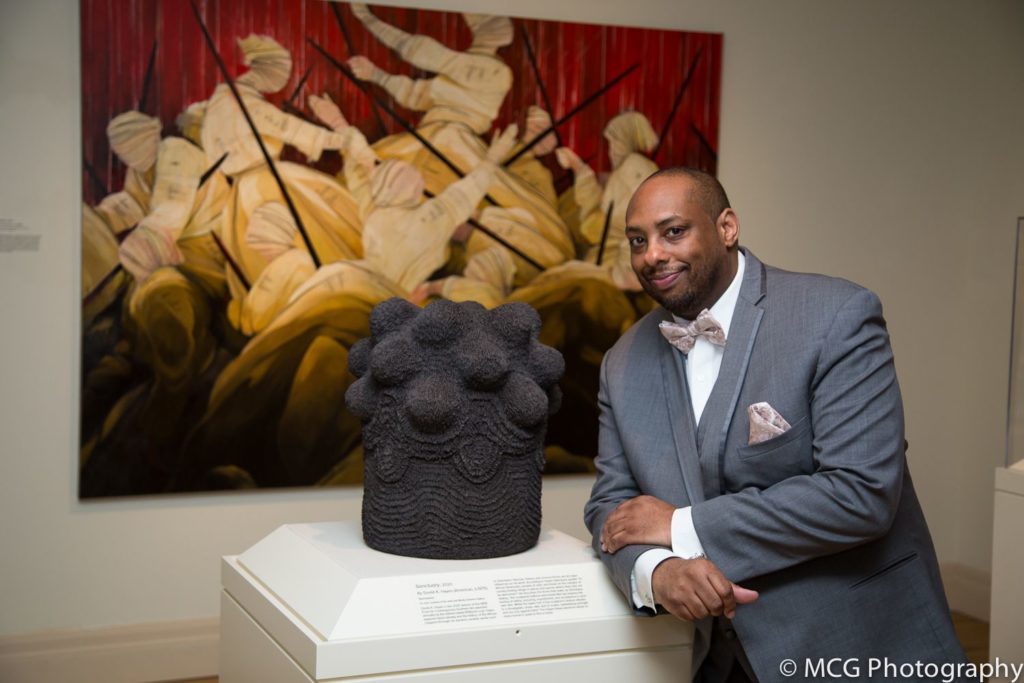CHARLESTON, S.C., February 1, 2021 – The Gibbes Museum of Art, home to the foremost collection of American art that incorporates the story of Charleston, is proud to announce the acquisition of three new artworks by African American artists to the permanent collection. The works are “Holy City” and “Eden” by Charleston-based artist Fletcher Williams III, and “Sanctuary” by the winner of the 2019 Society 1858 Prize for Contemporary Southern Art Donte K. Hayes. These pieces will be on view in the museum’s Mary Jackson Modern and Contemporary Gallery starting on Feb. 26.
“The Gibbes is committed to conserving and exhibiting collections of the highest quality and these new acquisitions contribute significantly to that effort,” said Angela Mack, the Gibbes Museum of Art’s executive director. “We are also working hard to diversify the artists represented in our collection to ensure that the Gibbes is presenting a more inclusive and truthful history of Charleston through the visual arts. These acquisitions were made possible by generous donors who recognize the importance of broadening our visual storytelling and are committed to supporting the work of contemporary artists.”
Fletcher Williams III is a Charleston-based artist whose works engage the rituals and traditions of the American South. He is interested in place and identity and has established a working methodology that incorporates found objects and natural materials in his art-making process. Williams often paints with Spanish moss, builds house-like structures with salvaged wood and tin roof and fashions delicate sculptures out of handwoven palmetto roses. His work is architectural and figural, tactile and multi-sensory, and unveils his curiosity for people and place, material and process. Williams was a 2019 Visiting Artist at the Gibbes Museum of Art.

“Holy City” by Fletcher Williams III
Williams created “Holy City” in 2015 as part of his installation Souvenir that commemorated African Americans who lost their lives to violence blocks away from Charleston’s historic tourist district—a stark contrast in reality from the celebrated charm of the city center. “Holy City” is a 45-inch-tall painted wood cross that features handwoven Charleston palmetto roses. Frequently found in his work, Williams believes the Palmetto Rose is infused with history and sentiment. Williams is interested in the innate beauty of the naturally crafted object as well as its history and often uses it in his sculpture as a means to represent the correlations of charm and decay, beauty and destruction. This piece was gifted to the museum by Jonathan Green and Richard Weedman.
“Eden” by Fletcher Williams III
“Eden” is the largest of nine works on paper presented in Williams’ 2020 exhibition installation Promiseland at the Aiken Rhett House. The artist began experimenting with the picket fence as a motif in his work while in residence at the Gibbes in 2019. His anthropomorphized pickets conjure complex questions around this simple symbol that has historically represented both the prosperity of the American dream as well as the line between the enslaved and the free. Created by taking multiple rubbings of a single fence post and then painted with Spanish moss, the overlapping and intertwining white pickets present a fictional landscape. According to the artist, “Several read as portals or gateways to unexplored utopias while others sit as unsettling fortifications. Together, they work to connect the physicality of natural and built environments with lived experiences as well as raise questions about boundaries and barriers and what we choose to protect and separate.” The museum purchased “Eden” with funding provided by Kathryn Salmanowitz.
Donté K. Hayes’s artwork is influenced by hip-hop, history and science fiction, and explores themes in Afrofuturism, a projected vision of an imagined future that critiques the historical and cultural events of the African Diaspora and the distinct black experience of the Middle Passage. Hayes works in clay as a historical and creative base material to inform memories of the past. Ceramics becomes a bridge to conceptually integrate disparate objects and or images to create new understandings and connections with the material, history and social-political issues. These ceramic objects are vessels, each making symbolic allusions to the black body.

“Sanctuary” by Donte K. Hayes
“Sanctuary” was created by the artist specifically for Charleston after he was awarded the prestigious Society 1858 Prize for Contemporary Southern Art. The ceramic sculpture is inspired by his research focused on the pineapple as a symbol of welcoming and hospitality, which he found is rooted in the history of slavery and agricultural colonization of the Caribbean, South America, and the Southern United States, particularly in South Carolina and Georgia. When a slave ship brought enslaved Africans to the port, the dock foremen would place a pineapple at the front of the dock to signify their arrival. The museum purchased “Sanctuary” with funding from the Alicia Rhett art acquisition fund.
Published Feb 1, 2021
Top image: Eden, 2019, by Fletcher Williams III (American b. 1987). Acrylic on paper, 72 x 120 inches. Museum purchase with funding provided by Katheryn Salmanowitz. ©Image courtesy of the artist Fletcher Williams III

